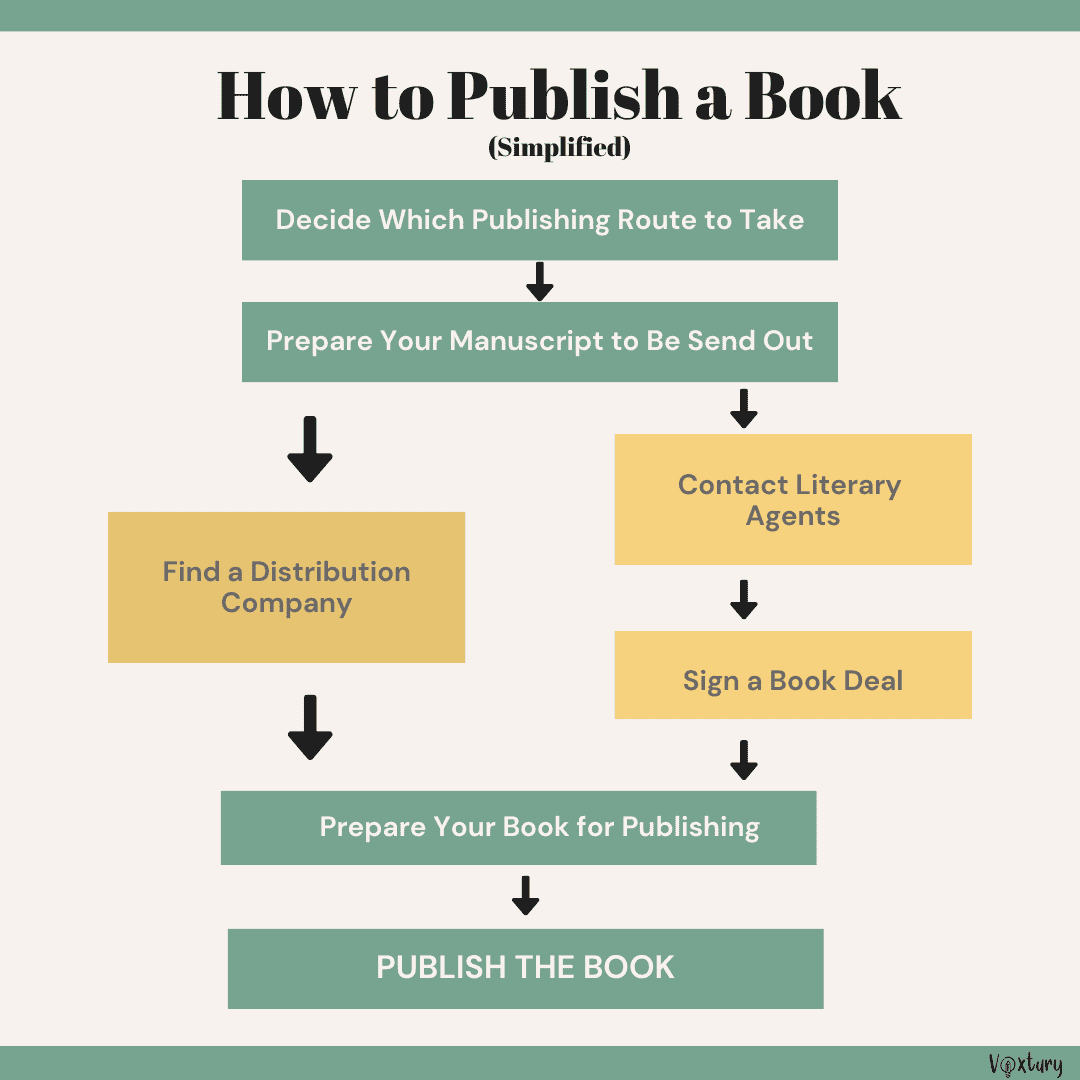Have you been writing a book and wondering about how the publishing process looks for when you want to take that next step in getting your work out to readers? Well, the truth is that, in itself, the process of book publishing is not that complicated. However, there are two things that can (and in most cases will) prolong it, depending on what kind of publishing route you decide to go with – money and timeline.
In this article, we will go through the steps to publish a book and explain what each of them entails so that you can prepare yourself for what is about to come once your manuscript is finished.
Step 1: Decide Which Route You Want to Take
The first major decision you will have to make when trying to publish your book is whether you want to take the traditional publishing or self-publishing route. Both of them have their pros and cons, so you should consider what both sides have to offer.
For example, traditional publishing is easier in the sense that almost all of the distribution and marketing is done by the publishing house you’re signed to. However, it often takes years before you find a publisher willing to offer you a book deal. Self-publishing, on the other hand, is significantly faster – however, it is also more expensive, as you take all of the expenses upon yourself.
As for royalties, traditionally published authors usually have significantly lower royalties than those who self-publish. This is mainly because the publisher is taking a risk and investing a lot of money without knowing whether it will turn out to be profitable. Traditional authors also receive an advance.
Overall, the decision you make cannot be rushed. It should be fully thought out, made after considering all of the advantages and disadvantages of either option.
Step 2: Prepare Your Draft to Be Send Out
Regardless of which route you decide to pursue, you need to edit your book to ensure it doesn’t contain any plot holes or grammatical errors – especially if you’re planning on submitting it to publishing houses.
Online editors like Voxtury are very beneficial in this case. While you will still need to re-read your book to catch any inconsistencies in the plot, online editor tools can help you with the more monotonous part, which is finding all the typos, duplicate words, and more. We live in a world full of technology, so why not take advantage of it?
What we would recommend as far as editing goes is giving yourself time – don’t rush into the editing process as soon as you finish the book, as many things will be missed that way. Instead, give it a week or two – trust us when we say that when you sit down to edit your book after giving yourself time away from it, you will see a lot more than if you were to just jump straight into it.
If you don’t want to edit your book yourself, try looking for freelancers. Professional editors and proofreaders can tell you not only about the mistakes in your book but also give you insight into how a reader will perceive your work.
You can also share your manuscript with your industry peers – a good idea is to look at writing communities and critique circles. You might also want to look for beta readers, although when doing so, make sure that they’re interested in the genre you’re writing, as they are already familiar with it.
To make the feedback you receive from them more helpful to your current and future work, you can send them a questionnaire that they will have to fill out once they’re done with your book. When doing it, think about the questions carefully. Their point is to help you understand what should be improved to make your work better, so make sure to use open questions, as that will allow you to really understand their impression of your book.
Some examples of questions include:
- Was the book enjoyable? Did the book pull you in? Did you feel the urge to continue reading once you started?
- Do the dialogues flow naturally, or do they seem forced at times?
- Was the world building too much? Were the descriptions too detailed?
- Were the sentences / chapters too long or just right?
- Is there anything you would change in the plot? If so, what was it?
- Were there any holes in the plot, or were some things unclear?
You can also send the manuscript to your friends and family, however, if you want constructive criticism, that might not be the best idea – even if they don’t want to be, their relationship with you will probably cause a bias in their opinion of your work. That’s why it’s better to work with people you have no connection with – they’ll be honest.
Step 3.1: Find a Distribution Company

If you decide to go via the self-publishing process, your next step will be finding the company that will be responsible for the distribution process of your book. Many authors choose Amazon as they’re the biggest one and offer distribution of several formats (e-book, paperback, hardcover, and Kindle Vella), but it does not mean you have to as well.
When just starting out, look for a print-on-demand service – your book will be printed only once a customer purchases it. This prevents you from being stuck with dead stock and having to spend a large sum upfront without knowing if your work will sell.
Step 3.2: Contact Literary Agents
As for traditional publishing, your next step should be finding an agent. While there are some publishers that will be willing to sign you even without an agent, having someone in your corner who knows the industry definitely makes things easier.
When looking for an agent, focus on your specific genre. While you can, of course, look for more generic agents, having an agent with experience in the specific field you’re trying to break into gives you access to someone who most likely has connections with publishers within your desired genre.
Curate a list of possible literary agents you would like to reach out to and send them your manuscript – however, don’t do it all at once. Send a few, wait a bit, and send another batch, ideally, once some of the ones you contacted have replied to you. If a while has passed and you still have no response, follow up with them – chances are they simply got too busy and forgot to reply to you or didn’t notice your email.
Once you submit your manuscript and you receive a positive response from an agent, they will take over the process of pitching it to publishers, specifically editors working for the said publishers. Keep in mind that it can take a while before you will be offered a book deal, so don’t stress too much if you don’t get it within weeks. It often can take months, if not years, and multiple tries with different publishers.
As for your agent’s pay – they typically don’t receive anything until after you sign a book deal. Once your book has been picked by a publisher, they will usually take 15% of the proceeds. If the book doesn’t sell, they don’t receive anything.
Step 3.2.1: Signing the Book Deal
Once an editor decides they want to publish your book, they will get in touch with your agent and share more information about the conditions of the deal, including the pay as well as the approximate publishing timeline. Then, you will most likely meet with the said editor, where you’ll have the chance to discuss revisions.
When both parties are satisfied with the outcome, it’s time to sign the book deal or the publishing contract, as some prefer. This document will contain everything associated with your book, including the advance you receive, the royalties division, whether you retain foreign publishing (the right to publish your book in other languages) or film rights, and more. Make sure to read it carefully before signing.
After the deal is signed, it’s time to prepare your book for publication.
Step 4: Prepare Your Book for Publishing
Whether you’re traditionally or self-publishing, you need to add final touches to your book so that it can be published. This involves formatting, preparing the cover, as well as the final round of editing, among other things. In self-publishing, you are responsible for this.
In traditional publishing, on the other hand, the publisher will take care of them. After signing a book deal, the editor will send you something called “the editorial letter,” which includes all the areas in which they think your book needs improvement. They will also mark suggested changes in the manuscript.
Not every proposed change will be something you agree with, so communication is important here – talk it out and figure out a way to satisfy both parties. Keep in mind that often, it takes several rounds of revisions to get to the point where the editor decides your book is good to go.
As for the cover, your editor might ask you for ideas and give you sample covers for you to choose from – however, the final decision is almost always up to the publisher.
This is also when you send out Advanced Reader Copies, also known as ARCs. ARCs are not finished copies of the book – however, they are good enough to be reviewed. One more round of proofreading, and your work is ready to be printed and distributed.
Step 5: Publish the Book
Once the book is ready, it can finally be published and distributed. It might seem like a long process, and it definitely is, especially in traditional publishing, where it can take even up to 1-2 years before your book hits the shelves.
Self-publishing is definitely quicker. Depending on how long the editing takes, whether you already have a cover prepared, etc., we’re talking about days rather than months. However, it is also more expensive, as you are the one taking on all the costs associated with publishing.
When your book is ready for printing, it’s time for the fun part – creating a marketing plan. If you want to create more buzz around your book from the start, a good idea would be to prepare a separate book launch plan.
Steps to Publishing a Book – An Overview

The Bottom Line
While the publishing process can take a while, it is all worth it in the end. There’s no better feeling than finally having the result of all your hard work in your hands. However, if you want to go through the traditional publishing route, you have to be aware of one thing – the industry can be hard to get into, especially if you aren’t an established name.
Does it mean it’s impossible? Of course not – you just have to prepare yourself that it might take longer for someone to pick your book due to limitations editors have on how many manuscripts yearly they can accept. Don’t let it discourage you. Remember – Rome wasn’t built in a day.
